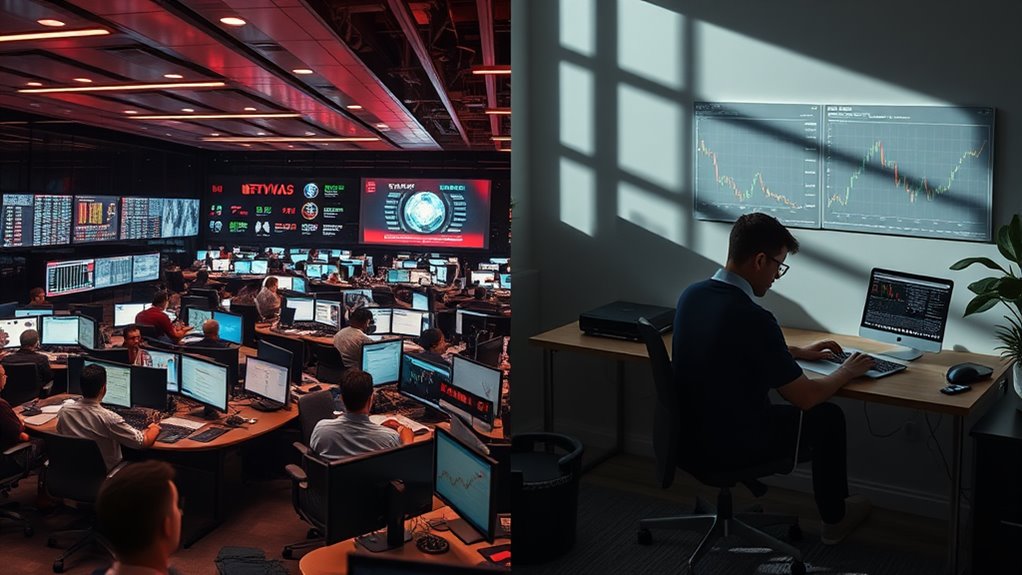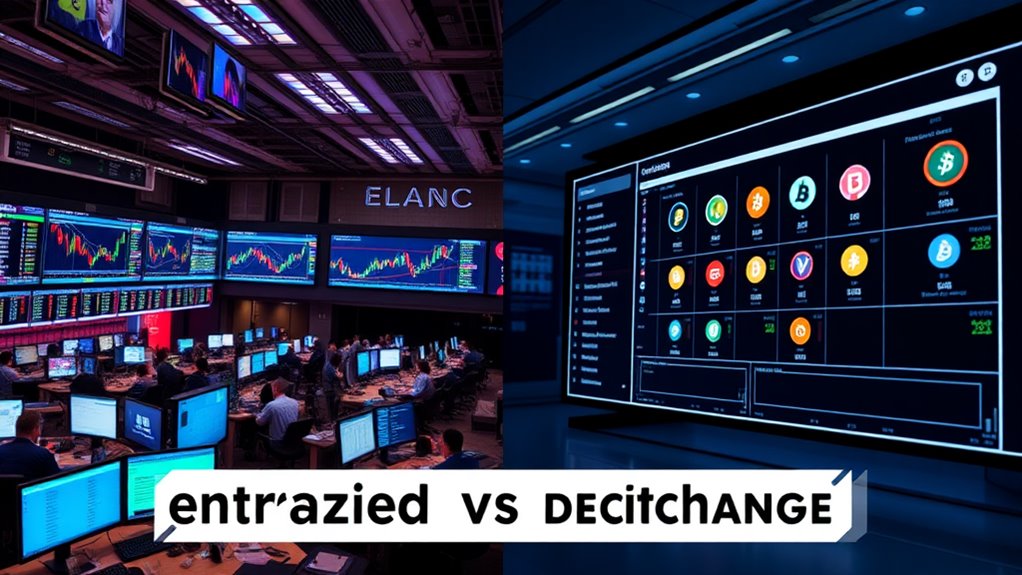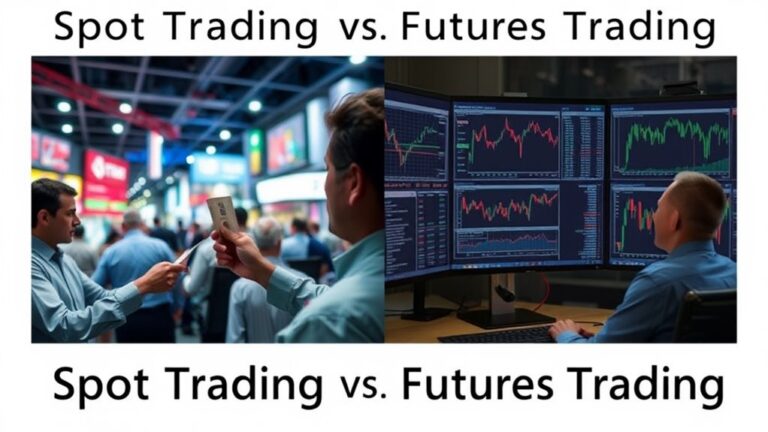
Centralized Vs Decentralized Exchanges: Which Is Right for You?
Centralized exchanges (CEXs) offer user-friendly interfaces, customer support, and fiat conversions, making them ideal for beginners. Decentralized exchanges (DEXs) provide self-custody of funds, greater privacy without KYC requirements, and access to emerging tokens, appealing to those with technical knowledge. CEXs excel in convenience but require trust in third-party custodians, while DEXs maximize control but demand more technical skill. Your choice depends on whether you prioritize ease-of-use or maintaining complete control over your assets.
Key Takeaways
- CEXs offer easier user experiences with intuitive interfaces and customer service, while DEXs require more technical knowledge but provide greater autonomy.
- Centralized exchanges control your funds but offer insurance protection, whereas decentralized exchanges give you self-custody but require responsible key management.
- CEXs demand identity verification but provide higher liquidity and faster trades, while DEXs offer anonymity with varying liquidity levels.
- Beginner investors typically benefit from CEXs’ user-friendly interfaces and support, while privacy-focused users prefer DEXs’ non-custodial approach.
- CEXs excel in trading established cryptocurrencies and fiat support, while DEXs provide earlier access to emerging tokens without geographical restrictions.
The Core Differences Between CEXs and DEXs

While both centralized exchanges (CEXs) and decentralized exchanges (DEXs) serve as platforms for cryptocurrency trading, they differ fundamentally in their operational structures and philosophies.
CEXs operate under centralized management with a CEO and board of directors, functioning as intermediaries that hold and control user funds. In contrast, DEXs run on blockchain protocols and smart contracts without a central authority.
The custodial nature of CEXs means users must trust the platform with their assets, while DEXs embrace a non-custodial model where users maintain control of their private keys and funds.
This key distinction reflects the broader cryptocurrency philosophy—CEXs prioritize convenience and accessibility through structured management, whereas DEXs emphasize user autonomy and the “be your own bank” ethos through community governance and direct blockchain interaction. Additionally, DEXs utilize liquidity pools to facilitate smooth transactions without relying on a central order book.
Security Profiles: Centralization vs. Smart Contracts

Security in cryptocurrency exchanges presents distinctly different risk profiles between centralized and decentralized systems.
Centralized exchanges maintain custody of user funds through concentrated storage, making them vulnerable to large-scale hacks that can affect thousands of users simultaneously. In contrast, decentralized exchanges operate through smart contracts where users maintain self-custody of their assets, distributing risk across individual wallets rather than creating a single attractive target for attackers. Additionally, implementing multi-factor authentication on centralized platforms can significantly enhance security and protect against unauthorized access.
Hack Risk Landscape
When comparing security profiles between centralized and decentralized exchanges, the hack risk landscape presents distinctly different vulnerabilities. CEXs face greater threats from large-scale hacks due to concentrated funds, though many offer insurance protection. DEXs, while resistant to traditional hacking, are vulnerable to smart contract exploits.
| Risk Factor | Centralized Exchanges | Decentralized Exchanges |
|---|---|---|
| Primary Vulnerability | Large-scale breaches | Smart contract bugs |
| Recovery Options | Insurance, compensation | Limited or none |
| User Responsibility | Minimal | High technical knowledge |
The security tradeoff is clear: CEXs provide protection through regulation and oversight but represent attractive targets for hackers. DEXs distribute risk but require users to manage their own security, with errors potentially resulting in permanent loss of funds. Staying informed about crypto-specific risks is essential for users navigating the security landscape.
Self-Custody vs. Custodial
At the core of exchange security lies the fundamental distinction between custodial and self-custody models. Centralized exchanges utilize custodial models where the platform itself holds and controls users’ private keys. While convenient, this approach makes these exchanges prime targets for hackers seeking to exploit a central point of vulnerability.
In contrast, decentralized exchanges operate on non-custodial frameworks, allowing users to maintain control of their private keys. This creates a security advantage as assets remain in users’ wallets until a trade executes through smart contracts.
While this enhances protection against large-scale hacks, it transfers responsibility to individual users who must secure their own keys. The self-custody approach offers greater privacy and autonomy but requires users to implement proper security measures to prevent unauthorized access. Additionally, security features such as two-factor authentication (2FA) can further enhance the protection of users’ assets, regardless of the exchange model chosen.
User Experience and Accessibility Comparison

The interface complexity between centralized and decentralized exchanges presents significant contrasts, with CEXs offering more intuitive designs and supportive features compared to the technical learning curve often required by DEXs.
Accessibility barriers become evident when comparing onboarding processes, with centralized platforms providing fiat on-ramps and customer support while decentralized alternatives demand prior knowledge of wallet management and blockchain mechanics.
These differences in user experience highlight how centralized exchanges prioritize mainstream adoption through simplified interfaces, whereas decentralized platforms trade immediate usability for greater user sovereignty and reduced intermediation. Additionally, the focus on security tips further emphasizes the need for users to be cautious when navigating these platforms.
Interface Complexity Spectrum
Maneuvering the world of cryptocurrency exchanges requires understanding the significant differences in user experience between centralized and decentralized platforms. The complexity spectrum varies widely, affecting how users interact with these systems.
- Centralized exchanges offer intuitive interfaces with fiat support, advanced trading tools, and dedicated customer service, creating a familiar environment for beginners.
- Decentralized exchanges typically present steeper learning curves, requiring knowledge of non-custodial wallets and smart contract interactions.
- Technical understanding becomes essential for DEX users who must manage gas fees and navigate blockchain congestion.
- User autonomy increases with decentralized platforms, giving traders direct control over their assets without intermediaries, but demanding greater personal responsibility.
As blockchain technology evolves, DEX interfaces continue to improve, gradually narrowing the complexity gap with their centralized counterparts. Additionally, many beginners find user-friendly interfaces beneficial when starting their trading journey, especially on platforms like Bybit and Coinbase.
Accessibility Barriers Analysis
Beyond interface complexity, accessibility barriers create considerable differences in how various user groups interact with cryptocurrency exchanges.
Centralized exchanges offer considerable advantages for beginners through user-friendly interfaces, fiat currency support, and extensive customer service systems. However, they require identity verification and account creation, which can deter privacy-focused users.
Decentralized exchanges, while eliminating KYC requirements and offering borderless access, demand greater technical knowledge and typically operate exclusively with cryptocurrencies. This creates entry barriers for newcomers unfamiliar with wallet management and blockchain technology.
Additionally, their lower liquidity levels and potential price volatility can impact transaction reliability. Furthermore, the security measures implemented by centralized exchanges, such as two-factor authentication, provide an added layer of protection for users.
The geographical reach also differs markedly—centralized platforms may face country-specific restrictions due to regulatory compliance, while decentralized exchanges provide unrestricted global access, though with limited support infrastructure.
Liquidity Factors and Trading Efficiency

Liquidity forms a critical foundation for effective trading in both centralized and decentralized exchange environments.
While centralized exchanges (CEXs) typically offer higher liquidity with faster transaction speeds averaging around 10 seconds, decentralized exchanges (DEXs) rely on user-funded liquidity pools that can vary considerably based on token popularity.
- CEXs execute trades instantly within their databases, allowing for minimal price impact and higher trading volumes.
- DEXs experience slower transaction speeds due to blockchain dependency, particularly during network congestion.
- Liquidity in DEXs is heavily influenced by user participation and incentives for liquidity providers.
- Regulatory environments affect liquidity differently, with CEXs facing stricter compliance requirements while DEXs remain more accessible in restricted regions.
Moreover, understanding order book depth can help traders gauge the market’s ability to handle large trades without significant price changes.
Fee Structures and Hidden Costs

The cost of trading cryptocurrency extends beyond just the published rates, encompassing both transparent and hidden fees that impact overall returns.
Centralized exchanges typically charge a fixed percentage per trade, ranging from 0.1% to 0.5%, with additional fees for deposits and withdrawals. These platforms often include hidden costs for services like fast transfers or asset insurance.
In contrast, decentralized exchanges primarily base their fees on blockchain gas costs, which fluctuate with network congestion. DEXs generally offer greater transparency, with fees clearly outlined in smart contracts.
While they often charge lower trading fees than centralized exchanges, the blockchain network fees can add significant costs.
Trading volume affects pricing on both exchange types, with high-volume traders typically benefiting from discounts. Understanding trading fees is essential for optimizing trading costs.
Regulatory Compliance and User Privacy

Regulations shape the operational landscape of cryptocurrency exchanges, creating a stark divide between centralized and decentralized platforms.
While CEXs must adhere to KYC and AML requirements, DEXs currently operate with greater regulatory freedom but face an uncertain future as government scrutiny increases.
- CEXs collect personal information for compliance, potentially exposing user data to security breaches.
- DEXs prioritize anonymity, allowing transactions without identity verification.
- Compliance costs on centralized platforms often translate to higher user fees.
- Regulatory uncertainty creates different risk profiles for both exchange types.
This compliance gap affects not only how exchanges operate but also the privacy protections afforded to users. As regulations evolve, both exchange types will likely experience shifts in their compliance obligations and associated privacy implications, especially with recent regulatory clarity efforts from the SEC.
Risk Assessment for Different Trader Profiles

Different cryptocurrency users face varying risk profiles when choosing between centralized and decentralized exchanges, depending on their experience level, trading volume, and investment goals.
Beginners typically benefit from centralized exchanges‘ user-friendly interfaces and customer support, despite higher fees and platform-wide security risks. Advanced traders may prefer centralized platforms for their liquidity and scalability, while appreciating decentralized exchanges for peer-to-peer trading options.
User experience dictates exchange choice—novices favor centralized support systems while experts balance liquidity needs with peer-to-peer autonomy.
Risk-averse traders often value the insurance and recovery processes offered by centralized exchanges, whereas high-volume traders prioritize the liquidity and execution speed centralized platforms provide.
Long-term investors might favor decentralized exchanges for non-custodial control, eliminating concerns about exchange bankruptcies or major security breaches.
Each trader profile must weigh these specific risk factors against their personal trading strategy and comfort level.
Market Access and Available Trading Products

Access to various trading assets represents a fundamental distinction between centralized and decentralized cryptocurrency exchanges. Centralized platforms typically offer a curated selection of established cryptocurrencies alongside traditional financial products like derivatives, while decentralized exchanges provide broader access to emerging tokens through different mechanisms.
- Centralized exchanges support fiat currency transactions, creating an entry point for traditional investors wanting to convert their dollars, euros, or yen into digital assets.
- Decentralized platforms feature flexible token listings through automated smart contracts, allowing nearly any token to be traded without formal approval processes.
- Derivative products such as futures and options are mainly available on centralized exchanges, catering to sophisticated trading strategies.
- New or innovative tokens appear first on decentralized exchanges, giving traders early access to emerging projects before they reach mainstream platforms.
Making Your Choice Based on Trading Goals

Selecting the right cryptocurrency exchange ultimately depends on what traders aim to accomplish with their digital assets.
For beginners or those prioritizing convenience, centralized exchanges offer user-friendly interfaces and robust customer support, despite requiring KYC verification.
However, privacy-focused users may prefer decentralized exchanges, which allow anonymous trading without identity verification.
Security considerations also influence this decision—CEXs provide institutional security but maintain custody of funds, while DEXs give users complete control of their assets through private keys.
Trading frequency matters too, as high-volume traders benefit from the superior liquidity and faster execution speeds of centralized platforms, though they typically charge higher fees.
Meanwhile, investors concerned about regulatory uncertainty might find decentralized exchanges more resilient against government interventions, despite requiring greater technical knowledge.
Frequently Asked Questions
How Do I Recover Assets From a Hacked Exchange?
Recovering hacked exchange assets involves immediate security measures, notifying the exchange and authorities, providing transaction details, engaging recovery services, and seeking legal assistance. Success varies based on the hack’s scale and exchange cooperation.
Can I Mine Cryptocurrency Directly Through Exchanges?
Most exchanges do not support direct cryptocurrency mining. Some centralized platforms like StormGain offer cloud mining integration, but exchanges primarily focus on trading services rather than providing direct mining capabilities to users.
Do Exchanges Offer Tax Reporting Tools for Crypto Transactions?
Like sailors steering through tax waters, cryptocurrency traders find most exchanges provide transaction history but not thorough tax tools. Users typically need third-party software like Koinly or ZenLedger to properly calculate and report their tax obligations.
How Do Flash Crashes Affect Different Exchange Types?
Flash crashes impact CEXs and DEXs differently. CEXs can implement circuit breakers and pause trading during volatility, while DEXs lack these protections, remaining vulnerable to market imbalances without centralized intervention mechanisms.
What Blockchain Networks Do Most DEXS Operate On?
Most DEXs operate primarily on Ethereum, followed by Binance Smart Chain, Solana, Polygon, and Avalanche. The choice of blockchain affects transaction speeds, fees, and token compatibility for decentralized trading platforms.
Conclusion
The choice between centralized and decentralized exchanges ultimately depends on your specific needs and risk tolerance. Like choosing between a bustling city center and a remote countryside retreat, each option offers distinct advantages. Consider your priorities regarding security, user experience, liquidity, fees, privacy, and regulations. By aligning your trading goals with the appropriate exchange type, you’ll find the platform that best serves your cryptocurrency journey.












